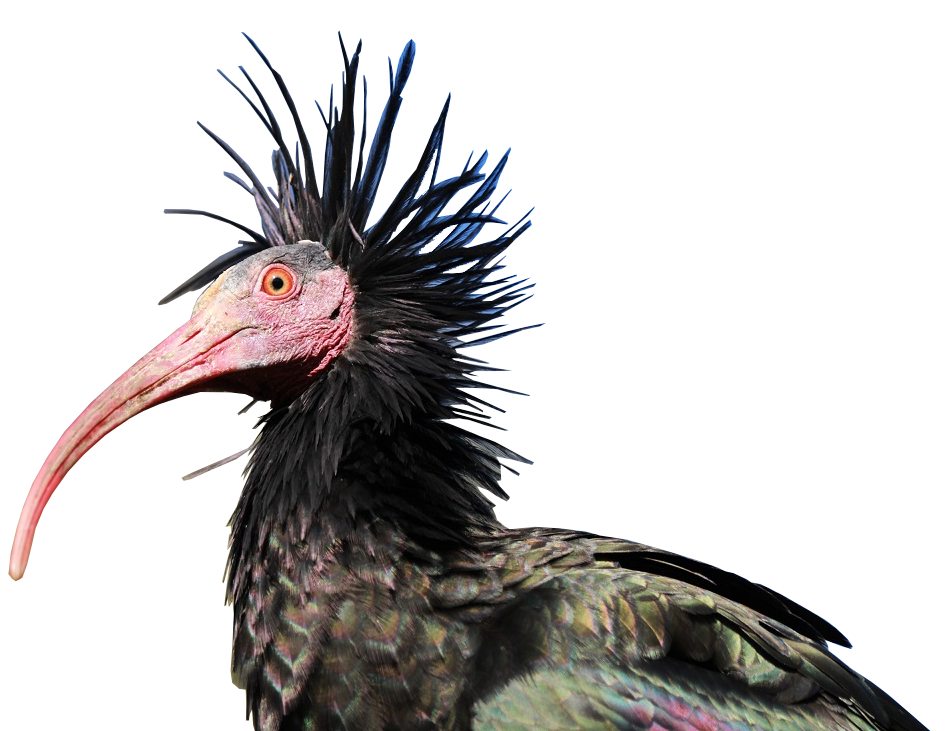As a highly endangered wild bird, the Northern Bald Ibis only resides in a fraction of its former range. Reliable historical evidence comes from the Swiss naturalist Conrad Gessner. His work shows that these ibises were found in Switzerland (Bad Ragaz), Austria (including Mönchsberg in Salzburg, and Schlossberg in Graz) and southern Germany (including Überlingen, Passau, and Kelheim). There is also increasing evidence that they went extinct in northern Italy, Spain, Hungary, and in the Balkans as far as Greece.
The first references to the persecution of Northern Bald Ibises came from records from the 16th century. The birds were coveted as delicacies and therefore pursued, including the young. The Northern Bald Ibis had already disappeared from Europe by the beginning of the 17th century, and for many centuries the stories about the black “crested ibis” were thought to be nothing but fables. This ibis was originally a migratory bird throughout its range, leaving its breeding grounds in autumn to find a more suitable habitat for winter. Although the Northern Bald Ibis can tolerate lower winter temperatures, food is often not available at this time of year. Known historical wintering regions included the west coast of Africa (Mauritania, Senegal) and the east coast of Africa (Ethiopia, Eritrea). Today however, most wild ibises no longer migrate in the historical way. The few remaining populations have lost their migratory tradition because of human influence, and are therefore referred to as sedentary.
Outside Europe, historical populations have been reported in northern Africa and the Arabian Peninsula to Turkey. In Egypt, Northern Bald Ibises probably became extinct 4,000 years ago, whereas they only disappeared in the rest of the non-European distribution area over the course of the last century. Today, there is only one sedentary population on Morocco’s Atlantic Coast, which has now grown to around 600 individuals thanks to international conservation efforts.
In the Turkish city of Birecik, there is still one colony of 250 individuals, that are the decedents of a previously migrating wild population. The birds have been breeding on a cliff in this city for at least 1,000 years and are therefore firmly anchored there. The colony once moved to Ethiopia in the winter and returned in the spring. After a devastating population collapse, due to pesticide poisoning in the 1950s, the remaining animals were taken into the care of humans, where they have lived ever since. The birds are captured each fall to discourage their perilous journey south.
In Syria, a relict population of seven bald ibises were surprisingly discovered in the ancient city of Palmyra in the early 2000s. The tagging of these birds showed that they had a migratory tradition and flew to Ethiopia for winter. Unfortunately, despite intensive protection efforts, the colony could not be preserved and in 2013, the traces of the last Northern Bald Ibis from Syria were lost. There are attempts to reintroduce a wild population in the Middle East, but given the current ecological, social, and political conditions, there is limited opportunity to do so.
Sedentary populations, established by humans, also exist in Europe. Since 2003, a reintroduction project has been running in Andalusia, Spain. In this location, there are currently about 100 birds, that have been breeding regularly for several years. Free-flying colonies also live at the Konrad Lorenz Research Center in Grünau im Almtal, in the Rosegg Zoo in Carinthia and at the Fagagna station in northern Italy. They are cared for all year round and spend the winters in aviaries.
Historical distribution
Migrating Population
Sedentary Population
















